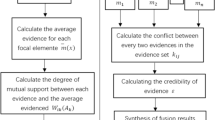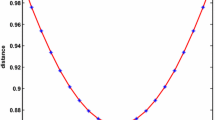Abstract
In temporal information fusion, the information collected by sensors is obtained dynamically with the passage of time. Unlike the spatial information fusion, temporal fusion should be dynamic. Evidence theory has been applied to fuse temporal and spatial information; however, existing temporal fusion methods do not treat conflicting and non-conflicting evidence sources distinctively. Moreover, unlike spatial evidence sources, which are obtained simultaneously, temporal evidence sources cannot be evaluated simultaneously to obtain their degree of reliability. Thus, it is necessary to develop a method for temporal evidence combination. In this paper, a self-adaptive combination method for temporal evidence is proposed based on the negotiation strategy. In the proposed method, a set called an evidence set is constructed by the cumulative temporal fusion results of the previous moment, current moment, and future moment. The evidence set is evaluated as conflicting or non-conflicting according to the maximum power pignistic probability distance between each pair of evidence sources in the set. Then, temporal evidence sources are self-adaptively combined by different methods according to the degree of conflict. Numerical experiments were conducted to evaluate the performance of the proposed method. The results indicated that the proposed method is sufficiently effective and robust to support decision making.
Similar content being viewed by others
References
Song Y F, Fu Q, Wang Y F, et al. Divergence-based cross entropy and uncertainty measures of Atanassov’s intuitionistic fuzzy sets with their application in decision making. Appl Soft Comput, 2019, 84: 105703
Zhang B, Zhang M L, Song Y F, et al. Combining evidence sources in time domain with decision maker’s preference on time sequence. IEEE Access, 2019, 7: 174210
Song Y F, Wang X D, Quan W, et al. A new approach to construct similarity measure for intuitionistic fuzzy sets. Soft Comput, 2019, 23: 1985–1998
Song Y F, Wang X D, Zhu J W, et al. Sensor dynamic reliability evaluation based on evidence theory and intuitionistic fuzzy sets. Appl Intell, 2018, 48: 3950–3962
Song Y F, Wang X D, Lei L, et al. A novel similarity measure on intuitionistic fuzzy sets with its applications. Appl Intell, 2015, 42: 252–261
Lei L, Song Y F, Luo X. A new re-encoding ECOC using reject option. Appl Intell, 2020, 50: 3090–3100
Dempster A P. Upper and lower probabilities induced by a multivalued mapping. Ann Math Statist, 1967, 38: 325–339
Shafer G. A Mathematical Theory of Evidence. Princeton: Princeton University Press, 1976
Fei L G, Lu J D, Feng Y Q. An extended best-worst multi-criteria decision-making method by belief functions and its applications in hospital service evaluation. Comput Industrial Eng, 2020, 142: 106355
Liu Z G, Pan Q, Dezert J, et al. Combination of classifiers with optimal weight based on evidential reasoning. IEEE Trans Fuzzy Syst, 2018, 26: 1217–1230
Fei L G, Feng Y Q, Liu L N. Evidence combination using OWA-based soft likelihood functions. Int J Intell Syst, 2019, 34: 2269–2290
Liu Z G, Pan Q, Dezert J, et al. Classifier fusion with contextual reliability evaluation. IEEE Trans Cybern, 2018, 48: 1605–1618
Fei L G, Feng Y Q. A novel retrieval strategy for case-based reasoning based on attitudinal Choquet integral. Eng Appl Artif Intell, 2020, 94: 103791
Liu Z G, Pan Q, Dezert J, et al. Hybrid classification system for uncertain data. IEEE Trans Syst Man Cybern Syst, 2017, 47: 2783–2790
Fei L G, Feng Y Q, Liu L N. On pythagorean fuzzy decision making using soft likelihood functions. Int J Intell Syst, 2019, 34: 3317–3335
Liu Z G, Liu Y, Dezert J, et al. Evidence combination based on credal belief redistribution for pattern classification. IEEE Trans Fuzzy Syst, 2020, 28: 618–631
Fei L G, Feng Y Q. An attitudinal nonlinear integral and applications in decision making. Int J Fuzzy Syst, 2020, 24: 1–9
Liu Z G, Zhang X X, Niu J W, et al. Combination of classifiers with different frames of discernment based on belief functions. IEEE Trans Fuzzy Syst, 2020. doi: https://doi.org/10.1109/TFUZZ.2020.2985332
Wu D D, Tang Y C. An improved failure mode and effects analysis method based on uncertainty measure in the evidence theory. Qual Reliab Engng Int, 2020, 36: 1786–1807
Hong L, Lynch A. Recursive temporal-spatial information fusion with applications to target identification. IEEE Trans Aerosp Electron Syst, 1993, 29: 435–445
Song Y F, Wang X D, Lei L. Combination of temporal evidence sources based on intuitionistic fuzzy sets (in Chinese). Acta Autom Sin, 2016, 42: 1322–1338
Chen Y F, Xa X Z, Hu D G, et al. Evidence combination based on tentative discount of evidences (in Chinese). Acta Electron Sin, 2014, 42: 756–765
Luo H, Yin Y P, Hu X X, et al. Method to modify evidence source based on trustworthy factors (in Chinese). Syst Eng Electron, 2015, 37: 1459–1464
Wen C L, Wang Y C, Xu X B. Fuzzy information fusion algorithm of fault diagnosis based on similarity measure of evidence. In: Proceedings of the 5th International Symposium on Neural Networks. Berlin: Springer, 2008. 5264: 506–515
Yu C, Yang J H, Yang D B, et al. An improved conflicting evidence combination approach based on a new supporting probability distance. Expert Syst Appl, 2015, 42: 5139–5149
Bi W H, Zhang A, Li C. Weighted evidence combination method based on new evidence conflict measurement approach (in Chinese). Control Dec, 2016, 31: 73–78
Hu C H, Si X S, Zhou Z J, et al. An improved D-S algorithm under the new measure criteria of evidence conflict (in Chinese). Acta Electron Sin, 2009, 37: 1578–1583
Liu Y X, Zhu Y P, Li X, et al. Integrated target discrimination model in missile defense system (in Chinese). J Electron Inform Technol, 2006, 28: 638–642
Wu J, Cheng Y M, Pan Q, et al. An effective multi-platform multi-radar target identification algorithm based on three level fusion hierarchical structure (in Chinese). J Northwestern Polytech Univ, 2012, 30: 367–372
Xu X B, Zhang Z, Li S B, et al. Fault diagnosis based on fusion and updating of diagnosis evidence (in Chinese). Acta Autom Sin, 2016, 42: 107–121
Liu W R. Analyzing the degree of conflict among belief functions. Artif Intell, 2006, 170: 909–924
Jousselme A L, Maupin P. Distances in evidence theory: comprehensive survey and generalizations. Int J Approx Reason, 2012, 53: 118–145
Jousselme A L, Grenier D, Bossé R. A new distance between two bodies of evidence. Inf Fusion, 2001, 2: 91–101
Tessem B. Approximations for efficient computation in the theory of evidence. Artif Intell, 1993, 61: 315–329
Zhu J W, Wang X D, Song Y F. A new distance between BPAs based on the power-set-distribution pignistic probability function. Appl Intell, 2018, 48: 1506–1518
Acknowledgements
This work was supported by National Natural Science Foundation of China (Grant Nos. 61703426, 61876189, 61806219), China Post-Doctoral Science Foundation (Grant No. 2018M633680), Young Talent Fund of University Association for Science and Technology in Shaanxi, China (Grant No. 20190108), and Innovation Talent Supporting Project of Shaanxi, China (Grant No. 2020KJXX-065).
Author information
Authors and Affiliations
Corresponding author
Rights and permissions
About this article
Cite this article
Song, Y., Zhu, J., Lei, L. et al. Self-adaptive combination method for temporal evidence based on negotiation strategy. Sci. China Inf. Sci. 63, 210204 (2020). https://doi.org/10.1007/s11432-020-3045-5
Received:
Revised:
Accepted:
Published:
DOI: https://doi.org/10.1007/s11432-020-3045-5




